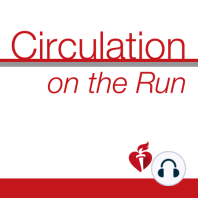20 min listen
Circulation September 19, 2017 Issue
ratings:
Length:
23 minutes
Released:
Sep 18, 2017
Format:
Podcast episode
Description
Dr. Carolyn Lam: Welcome to Circulation on the Run. Your weekly podcast summary and backstage pass to the journal and its editors. I'm Dr. Carolyn Lam, Associate Editor from the National Heart Center and Duke National University of Singapore. Today we will be discussing the cost effectiveness of statin use guidelines for the prime and prevention of coronary heart disease and stroke. Comparing the 2013 American College of Cardiology American Heart Association guidelines with the adult treatment panel three guidelines. A very important and current discussion that you don't want to miss. All coming up right after these summaries. The first original paper in this week's journal is the largest study yet reported that assessed the long term outcome of Takayasu's Arthritis. First author, Dr. Comarmond, and corresponding author Dr. Saadoun and colleagues from Hospital Pitie-Salpetriere in Paris performed a retrospective, multi-centered study of 318 patients from the French Takayasu network including patients with Takayasu Arthritis fulfilling the American college of Rheumatology and/or Ishikawa criteria. They found that, firstly, 50% of Takayasu arthritis patients relapse and experienced a vascular complication at ten years. Secondly, male sex, elevated CRP, and carotidynia were independently associated with relapse and with a two-fold higher risk of relapse. And thirdly, patients at high risk for vascular complications could be identified according to presence of two or more of the following risk factors: progressive clinical course diagnosis, thoracic aortic involvement, and or retinopathy. In summary, these factors identify patients with a high risk of relapse or vascular complications and may therefore serve to adjust more aggressive management and close follow up in Takayasu's Arthritis. The next study provides experimental evidence for a pathogenic role of the transcription factor interferon regulatory factor five or IRF-5 in atherosclerosis. In this study from co-first authors, Dr. Seneviratne and Dr. Edsfeldt, corresponding author Dr. Monoco from Kennedy Institute of Rheumatology in Oxford, United Kingdom, and colleagues. The authors showed that atherosclerosis prone apple-E negative mice who were also deficient in IRF-5 showed reduced atherosclerosis lesions and necrotic core formation. They found that the development of the lesion necrotic core was controlled by IRF-5 through impairment of macrophage dead cell removal, or spherocytosis. They further demonstrated that the CD-11C gene was a direct target of IRF-5 in macrophages and that IRF-5 was important in maintaining CD-11C positive macrophages in atherosclerotic lesions. In summary IRF-5 was shown to be a potential therapeutic target since its inhibition could reduce plaque inflammation and necrotic core size, thus potentially promoting a stable plaque phenotype with a lower risk of acute clinical complications. The next study is the first to assemble a transcriptomic framework of multiple cardiac cell populations during post natal development and following injury, thus enabling comparative analysis of the regenerative or new natal state, compared to the non regenerative or adult state. In this study from first author Dr. Quaife-Ryan and co- corresponding authors Dr. Porrello from the Royal Children's Hospital and Dr. Hudson from the University of Queensland, Australia. The authors isolated cardiomyocytes, fibroblasts, leukocytes and endothelial cells from infarct and non infarct neonatal and adult mouse hearts. The then performed RNA sequencing on these cell populations to generate the transcriptome of the major cardiac cell populations during cardiac development, repair and regeneration. They further, surveyed the epigenetic landscape of cardiomyocytes during post natal maturation by performing deep sequencing of assessable c
Released:
Sep 18, 2017
Format:
Podcast episode
Titles in the series (100)
Circulation December 19/26, 2017 Issue: Circulation Weekly: Your Weekly Summary & Backstage Pass To The Journal by Circulation on the Run
